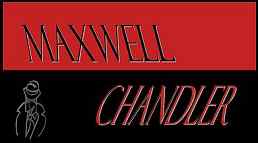
| Page One of Maxwell Chandler's reviews. | ||||||||||
![]()
Miles Davis: Filles De Kilimanjaro (Columbia/Legacy)
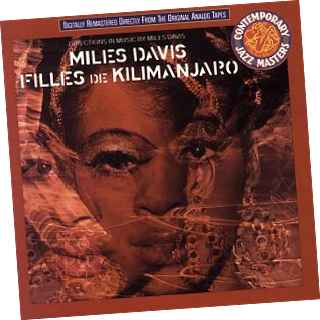
Miles Davis-trumpet
Wayne Shorter-tenor saxophone
Herbie Hancock-electric piano
Ron Carter-electric bass
Tony Williams-drums
(on tracks 1&5)
Dave Holland- bass
Chick Corea-electric piano
There are many misconceptions about this album. It is neither as great nor as terrible as people say.
It comes from two 1968 sessions that found Miles right on the verge of drastically changing his approach to song composition, size and manner of his ensemble and the actual mechanics of his playing. When this album is discussed the fact that the sessions encompassed two bands is always mentioned. This is a bit misleading. The amount and types on instruments on all tracks are same only the substitution of two players actually occurs and even then, both pianist are using electric piano. This would be bassist Ron Carters last album with Miles and the only one in which he played electric bass.
Gil Evans was present for these sessions. His contributions have been kept vague and this album should not be looked at as another Miles Davis/Gil Evans collaboration (Porgy And Bess, Sketches Of Spain, Miles Ahead) There is no symphonic coloring so beautifully realized on their other three works.
Style wise this album straddles the line between the work of Miles second great group (1965-’68 quintet : Shorter/Carter/Hancock/Williams) and the very start of Miles electric phase. I say the very start because the electric albums he made right before his retirement of the 1970’s are not as accessible as this one, although ultimately they offer up more rewards to listener.
The album includes one bonus track and features 24-Bit remastering. The sound is very impressive. There is a noticeable difference from the version out on CD a few years ago. It clocks in at about 70 mins. Good liner notes with an added update from 2002.
The whole band plays great. As matter of personal taste I think the keyboards at certain points sound a little dated (not as bad as some stuff found on progressive rock albums) but I personally would have preferred just brief washes. Chick Corea does do some pulse like tones on Frelon Brun sowing the seeds of techno ambient that Brian Eno would so successfully harvest. For the most part though the keyboards are played/presented much the way an acoustic piano would have been. In the coming years, for better or worse their role and tone would change, becoming more prominent and not always to good effect.
On Tout De Suite, witness the midsection where Tony William’s frenzied hi-hat assault conjures up sound of rain.
The standout track (for me) is Mademoiselle Marby. Named for Miles then new second wife. She was a singer/scenester who introduced Miles to Jimi Hendrix. The song actually incorporates Jimi’s The Wind Cries Mary in its melody. The use of space gives the illusion of time stopping which would be perfected on the next album In A Silent Way, but here seems more effective for lack of any discernible climax. In keeping with the dreamy aspect, Wayne Shorter enters the piece like someone whispering something as you are drifting off to sleep.
Throughout, Miles tone is an interesting mix. He switches from tone/attack of ‘65 quintet to the reverbed/treated tone he would largely use for albums immediately leading up to his retirement. The switching back and fourth does make for good drama and tension which was sometimes lacking during this period in his playing as far as tone went. Electric instruments aside, all the players sound as they had both in tone and what they would play on the previous, often brilliant albums.
This too would drastically change within the space of two albums. For many long time Miles aficionados this was the last album worth listening to. One of the albums strengths is that the album does have a unified feel to it. It is not easy or simple music, but it does seem less “intellectual” than the ones which had immediately preceded it (‘65-68) yet it was not as unrecognizable to old fans as what was to come. The accessibility seems to stem from the fact Miles was right about to switch gears. Part of his genius had always been the ability to pick the best of the litter to play with and to be inspired by. I think this is his first album though to be inspired by and draw from many influences at once. There is still the admiration which he had, had since the late fifties for pianist/composer Ahmad Jahmal and his use of space in playing and composition, but now he was drawing from the zeitgeist of jazz/funk/rock and such then obscure things as composer/sonic collager Karlheinz Stockhausen.
The next two albums would sound drastically different, each one growing in scope. Hard to “get” at first but well worth it. This album is a direct link to those two (Bitches Brew and In A Silent Way) It hints at what was to come without going there and loosing those unwilling or unable to follow. I would recommend this album almost as an appetizer to the main meal of Bitches Brew and In A Silent Way. A feast for the senses.
-Maxwell Chandler- Feb ‘05
![]()
Charles Mingus: Mingus Dynasty (Columbia/Legacy)
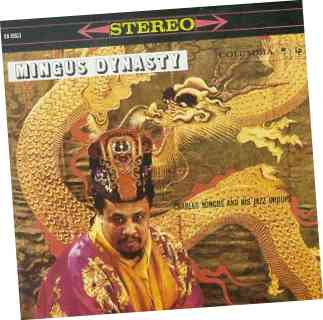
Richard Williams, Trumpet
Jimmy Knepper, Trombone
John Handy Alto, Saxophone
Booker Ervin Tenor, Saxophone
Benny Golson Tennor, Saxophone
Jerome Richardson, Baritone Saxophone
Roland Hanna, Piano
Charles Mingus, Bass
Danny Richmond, Drums
Teddy Charles, Vibes
This is one of my favorite Mingus albums. I got this when it first came out on CD years ago. It has been remastered and the sound fidelity is drastically improved. You hear Mingus’s cries, spurring the band on and at one point conducting the horn section on their next lines with a falsetto cry of “dwee-do-dwee” Also many of the tracks have restored solos. These new unedited versions appearing for the first time.
It is currently available remastered as a single CD or as part of a three disc set titled Charles Mingus The Complete 1959 Columbia Recordings. The boxed set includes the other album Mingus Ah Um and Mingus Alternate Takes. I recommend springing for the boxed set. The packaging is nothing special. Nothing like the Columbia boxed Miles sets, these are just the three CDs looking as they would if you bought them individually, but contained in a cardboard slip case. Still, if you like either of these albums you will like the others too. The alternate takes CD is a revelation of the level of spontaneity Mingus kept, even in his more score like pieces.
Charles Mingus was a great musician, he also wrote songs. Of more importance though is his reputation as a legitimate composer. A reputation which is still burgeoning in America despite the constant popularity of The Mingus Big Band (a Grammy winning ensemble which has worked for years directly with Mingus’s widow Sue) This album is perfect example of Mingus’s compositional skills. Much like Bela Bartok Mingus combined classical music with the musical idioms of his environment and heritage. Bartok had the gypsy Hungarian folk music, Mingus had blues and gospel. In my opinion some of Mingus’s most compelling work were not his songs, but his symphonic/orchestral pieces. He always strove for a classical complexity which married the spontaneity of jazz. What is of interest too is no matter how large an ensemble he played or wrote for this is not big band music nor was it third stream.
The album is all originals with two covers. Mood Indigo by Duke Ellington and Things Ain’t What They Used To Be by Mercer Ellington. The start of Mercer’s song the pianist actually conjures up that cascading water effect Duke was so found of employing when he himself played.
The stand out track is Song With Orange which starts with a nod to Duke with its slow, lush flutter of instruments. It quickly switches gears though becoming pure Mingus. The band here is top notch. Many of the musicians had played with Mingus in various combinations over the years. Of interest is the presence of Benny Golson. A fantastic musician, but also a writer of several jazz standards. It was around this time too Benny Golson and Art Farmer were creating some amazing albums with their own larger ensembles (sextet and octet recordings)
Four of the albums nine original tracks appear for the first time unedited. Aside from that there is a bonus track Strollin featuring vocals by Honey Gordon (the lyrics were written by her father Nat Gordon) and a burning solo by Booker Ervin.
This is a composer, this should be known and treasured.
- Maxwell Chandler - Oct 2004
![]()
Joe Henderson: Mode For Joe (Blue Note) Rudy Van Gelder Edition.
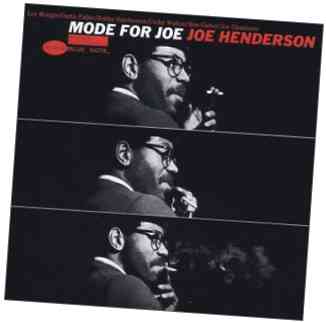
Lee Morgan-trumpet
Curtis Fuller-trombone
Joe Henderson-tenor sax
Bobby Hutcherson-vibes
Cedar Walton-piano
Ron Carter-bass
Joe Chambers-drums
There are widely varying opinions on the later recordings and career of Joe Henderson. An undisputed fact though, in the 1960’s he never made a bad album. Whether under his own name or as a “side man” everything he did during this time on Blue Note is worth having.
Joe Henderson has always been the double threat of top notch player and composer. The now standard Recorda Me was written by him when he was only fourteen. A generation before there was the holy jazz trinity of Coleman Hawkins, Lester Young and Ben Webster. Jump up a generation then you had John Coltrane, Wayne Shorter and Joe Henderson. (before you send me e-mails of complaints I see Sonny Rollins as link between two groups) For me the appeal of Joe’s playing was what it encompassed. His playing never got as outside pocket as Coltrane’s would, nor did he remain as clean and note perfect as Wayne Shorter. He incorporated aspects of these two contemporaries along with his very own distinctive artistic vision. His Blue Note years posses an immediately identifiable sound and way of playing.
This album was the largest ensemble Joe had used; a septet and his last record for Blue Note. All the musicians had worked together before in different configurations. Style wise this has similar feel to Horace Silver’s The Cape Verdean Blues which had Joe on tenor but J.J Johnson on trombone. Although Joe played on Lee Morgan’s famous Sidewinder album, he was most often teamed up with tenor man Hank Mobley. It is always refreshing hearing him in a different setting.
This album has no weak links as far as both players and songs are concerned. On most of his Blue Note dates Joe had used either Elvin Jones or Pete La Roca on drums. Here Joe Chambers takes up the sticks doing the company he keeps proud. Lee Morgan as always is fantastic. His splatter school style of playing always sounds extra compelling to me when he has a larger ensemble under him. The combination of his horn with Bobby Hutcherson Vibes is very distinctive and any albums in which they both appear is worth seeking out (Lee Morgan’s The Procrastinator see my review)
As enjoyable as the entire album is the two stand out tracks for me are Caribbean Fire Dance which feature what may be the only recorded samba-bop trombone solo. Joe Chambers seems to be channeling Tony Williams on this piece. Over all it has a fantastic tribal feel. Lee Morgan’s wailing entrance to solo is most memorable. The Lee Morgan penned tune Free Wheelin is also very good. It sounds similar to Ginger bread Man off of Miles Davis Miles Smiles album. Ron Carter starts things off with a snaking bass line, only appropriate since he played on both albums.
The sound quality is top notch being remastered RVG edition. The CD comes with one bonus track
With Joe Henderson and his sixties Blue Note albums there is no wrong place to start, get them all.
-Maxwell Chandler- Sept 2004
![]()
Gerry Mulligan: Night Lights (Mercury)
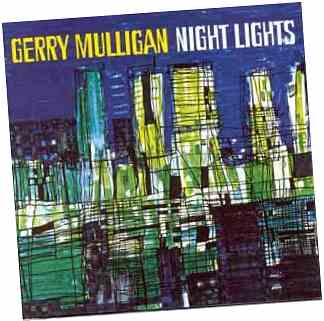
Gerry Mulligan: baritone saxophone, piano on 1
Art Farmer: trumpet and flugelhorn
Bob Brookmeyer: trombone
Jim Hall: guitar
Bill Crow: bass
Dave Baily: drums
I once again leave the familiar comfort of my hard-bop for this CD. Gerry Mulligan was not only a great musician but a top notch composer and arranger. With Miles Davis, Gil Evans and a handful of others he helped birth both cool jazz and third stream music. Cool Jazz has become confused with smooth jazz/soft jazz, the name in itself becoming a pejorative term.
This CD is perfect place for the Gerry Mulligan novice to start as it is very much a safe blend of the two types of albums he made. Most of his albums fall into either quartet dates which some people found too routine in their conception, while his other dates were larger ensembles (his Village Vanguard Orchestra whose recordings are hard to come by but highly recommended) which some people find “too big bandish” The unifying factor is always Gerry’s Playing. He always managed to shift emotional gears so rapidly and effortlessly that when you first start listening it is under appreciated all the shifts being almost imperceptible. But a spectrum of moods are always there. There, in each song a constant tone conveying a world weary melancholy, an injection of humor and even an authentic romanticism all ebb and floe underlined by an ever present swinging.
The sextet are all very good. Harder than people realize is for a larger ensemble to maintain an organic feel. Nothing is ever sacrificed here though, no loss of spontaneity or soul. Gerry Mulligan’s most famous horn association was with Chet Baker and their ground breaking (and short lived) pianoless quartet. Art Farmer is an even better foil for him. Art Farmer played with Gerry in both larger ensembles and some quartet dates too. Unlike Chet Baker, he varied both tone and attack. Art went on to gain even wider recognition with the work he did with Benny Golson. Bob Brookmeyer is another father of third stream and a great arranger in his own right. His playing here is good and very much used to strengthen the back ground of each piece. Jim Hall on guitar is tastefully understated sometimes adding more textural sounds than notes.
The CD clocks in at just over half an hour. It is a mix of originals and a few unique covers.
What is surprising is that the album has a unified feel to it, an almost unsaid emotional theme. The CD sounds like night, late night, and manages to convey that sense of late night light.
The blurred lights of the city as you drive home from a club, the dim light in the hall as you dump you change on the dresser and flop onto bed, the soft red light of the clocks face as you wait for dawn to come. The stand out track for me is “Morning Of The Carnival” from Marcel Camus (no relation to Albert) Black Orpheus which is a retelling of the Orpheus myth in Brazil during carnival. It is a sad samba which never once slips into parody, managing to tell the tale in just five minutes.The sound quality is good. There is one bonus track, the title track redone two years later with an added ten piece string section and Gerry on clarinet. Nice but not important. The liner notes are a little sparse, but I think that is partially due to where this fell in Gerry’s catalog.
Gerry Mulligan is not the first cat the younger or new jazz fans will purchase, but this album is perfect. You get all the joy that comes from Gerry's playing but are not required to be into big band/third stream.
A buried treasure found.
-Maxwell Chandler August '04
![]()
Jimmy Smith: Cool Blues (Blue Note. Rudy Van Gelder Edition)
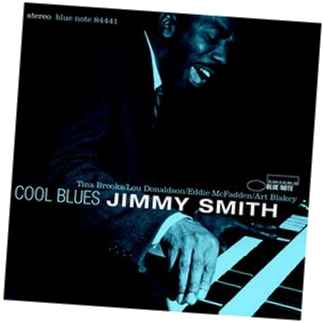
Lou Donaldson: alto sax
Tina Brooks: tenor Sax
Jimmy Smith: organ
Eddie McFadden: guitar
Art Blakey: drum (#1-3)
Donald Bailey: drums (#4-8)
I just got this album as a birthday gift. It is quite the discovery for me. I would never have bought a CD with organ on it! To me organs always dredged up thoughts of roller skating rinks, church and calliopes.
This album is a live recording from Small’s Paradise in Harlem. Along with The Village Vanguard and Minton’s, one of jazzes legendary clubs. It was actually at this club that Jimmy was discovered by Alfred Lion of Blue Note.
For me one of the surprises was that even though it was Jimmy Smith’s date the organ is kept way in the back ground unless it is doing a solo. And even the solos are not bad or long. If you can deal with a Doors song, then you can deal with this. Jimmy Smith possesses a far less abrasive tone than The Doors (Ray Mazerek) and a far more intricate style of playing. He was 28 before he actually started playing his instrument. Amazing to conceive of when you think that he pretty much brought the organ into jazz and also was the one who established how it should be played. He rented an organ to play for one dollar a day until he could afford to buy one. Once he could, he housed it in a empty warehouse where he spent entire days practicing. He didn’t release an album under his own name until he was twenty nine. Jimmy Smith is one of those handful of musicians that spent all his free time woodshedding it. Like Clifford Brown and (later) John Coltrane, he didn’t let anything get in his way of honing his craft.
The entire band is in top form. There is an extreme emphasis placed on the long groove. This is often just one small aspect of an ensemble hard bop date but here it is the main goal. There are plenty of fiery solos from each player but they all seem to feed back into the theme of each piece and back into the groove. The whole CD has a dance-e feel to it much in the same way as the title cut of Horace Silver’s Song For My Father.
This is essentially The Jimmy Smith trio with guest stars. There is no weak link in this band. Tina Brooks on tenor is amazing. He died way too early and left behind a small catalog. Only three albums under his own name which were not released in his lifetime and some essential Blue Notes where he served as a side man. (anything by Jackie McLean with him on it is worth having) Lou Donaldson is another recent favorite of mine. He is more than comfortable in this setting, going on to incorporate this greasy-soul sauce sound on his own albums with organ chores taken up by John Patton or Lonnie Smith. His alto makes for a nice contrast both in tone and style from Tina Brooks horn. One thing I found interesting, no bass. I didn’t even miss it or realize it until I was looking at album notes to see who was doing what.
The song selection is interesting. They start off with a traditional Russian song I have always liked called Dark Eyes. Hearing this makes me wonder why this song has not become part of the jazz lexicon. There is also one of the best versions of Dizzy Gillespie’s A Night In Tunisia I have ever heard. It grooves, swings and smokes. Each song is long in length and it is testament to how good they are at laying down the groove that not one moment feels as if it goes on too long.
The album cover is a photo by Francis Wolf, who did all of Blue Notes cover pictures. It is iconic in the same way as John Coltranes Blue Train and Sonny Rollins Volume 2 .
The CD is remastered using the 20 Bit K mapping. The sound quality is excellent only the chatter of the musicians being heard in-between songs.
I have always liked sax player Stanley Turrentine’s tone but most of his albums have organ on them, so I had always shied away from them. I will now give it a try along with a few more by Jimmy Smith. Older, wiser and obeying the groove.
-Maxwell Chandler
August 2004
![]()
John Coltrane Quartet: Crescent (Impulse!)
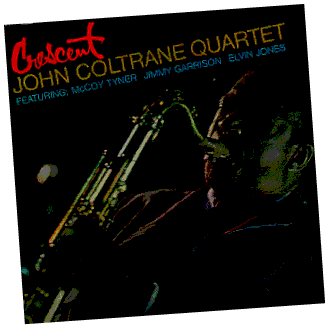
John Coltrane - tenor saxophone
McCoy Tyner - piano
Jimmy Garrison - bass
Elvin Jones - drums
Crescent is often overshadowed by its more famous sibling A Love Supreme. Recorded around the same time, both offer up a sonic journey of amazing emotional power.
I think A Love Supreme received more attention because there is an almost tangible immediacy in tone and execution to the suite like piece. Crescent is just as good, just different. Through out the album there is a melancholy feel that is absolutely beautiful. Coltrane’s classic quartet would recorded several more albums together, but an accelerated artistic evolution on John Coltrane's part made it so that this album was almost a summing up of where they had been. John Coltrane would continue to evolve incorporating a more free jazz feel, discordance and additional musicians such as Archie Shepp and Pharaoh Sanders.
The playing is top notch all around. Even though it was one of the things that made them famous, the interplay between the members of this quartet is always a marvel to hear never losing its power, even with repeated listening.
The tunes all have a denseness that verges on symphonic, yet because the pieces are not played at break neck speed never does it become overwhelming. There are five pieces on the album, each of a generous length. The whole album offering up about forty minutes of stimulation. The actual sound quality of the recording is pristine. Impulse uses the 20 bit K super mapping.
For me, Gustav Mahler and John Coltrane are two of the only people I can think of who managed to combine intellectualism and spirituality in their music. Unlike some of his other Impulse! recordings this one is perfect place for someone just getting into him to start, but will never lose its power with the eventual familiarity.
-Maxwell Chandler
July 2004
![]()
Hank Mobley: Workout (Blue Note)
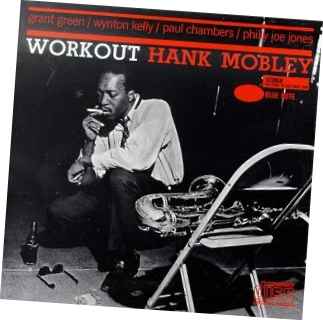
Hank Mobley - tenor Sax
Grant Green - guitar
Wynton Kelly - piano
Paul Chambers - bass
Philly Joe Jones - drums
If ever jazz had someone that could be called an underdog, it was Hank Mobley. Aside from jazz enthusiasts, his rise, fall and body of work just are not as well known as they should be.
He was in Art Blakey’s Jazz messengers holding down the front line at various times with Freddie Hubbard, Lee Morgan and many other Blue Note luminaries.
During what many consider Blue Note’s golden age he was a “side man” on seminal albums by the likes of Horace Silver and his frequent partner Lee Morgan. He released some classics under his own name during this time at Blue Note too, such as The Turn Around, Roll Call and No Room For Squares.
The proper lack of respect for his playing and body of work can be traced to a few key factors. During his heyday there was also John Coltrane, Wayne Shorter and Joe Henderson, all in their prime. Although there was never any outright competition (Hank actually playing with Coltrane, Zoot Sims and Al Cohn on Tenor Conclave and then with Coltrane again, along with Johnny Griffin on Johnny Griffin’s album A Blowing Session) Hank had not come up with new things to do with his instrument (Coltrane) He did not pen countless standards on his way to inventing a new genre of jazz (Shorter). Nor did he, despite the leanings of a few later albums ever become extremely forward thinking in his attack or the pieces he played (Henderson)
Miles Davis had made a few offhand disparaging remarks about Hank, but what people forget is that he had done and would later (again) do the same thing to Coltrane.
It was with pianist Wynton Kelly, bassist Paul Chambers and drummer Jimmy Cobb that Hank would join what would be known as Miles' transitional band.
They cut the vastly underrated (March) 1961 album Someday My Prince Will Come and also the Live In Person Friday And Saturday Night at The Blackhawk (April 21-22)
The few good things written about Someday... usually focus on the guest stars (Coltrane’s last ever with Miles for two songs and Philly Joe Jones for one) but listen to the tracks with just the “regular” band, they swing, they are tight and ripe with emotion. The Blackhawk recordings, now remastered and available as a boxed set, are one of the most compelling documentation of a live band. There is little logic in slighting this band. By this point Miles could have played with anybody, he choose these guys. Ultimately they did not get as outside pocket as he was seeking, but that is irrelevant in context of talent.
The group would leave Miles enmasse shortly after this. Wynton Kelly and Paul Chambers would appear on many of Hank’s solo album and the three of them would also appear on other 60’s Blue Notes together too. The rhythm section minus Hank would form a successful partnership with guitarist Wes Montgomery.
From Miles' comments which were often taken as gospel were the seeds of this attitude. Even in the linear notes for this, his own album, one can sense it. The echo of the title middleweight champion. Ira Glitter uses this term and while the term and linear notes are most likely not meant to be pejorative they do come across as condescending. It would not be the first or last time unfortunately. This would lead to anger and frustration which led to various forms of self poisoning. It became a vicious cycle, one problem feeding into the other.
Workout was recorded in 1961. Hank Mobley was in the midst of a golden period. The album has not been remastered or give the Rudy Van Gelder (RVG) treatment, but the sound quality is excellent. A lot of the RVG series are albums people would buy, or know of, regardless. One can hope that future releases will be titles that need that extra boost to catch the novice’s attention. There is one added track and the original liner notes are reproduced too.
Hank never drastically changed his playing style, but this recording finds him playing with a mellow, legato like sustain not found on earlier recordings. All of his solos are logical and to the point, showing an old school approach to song construction and execution.
Wynton Kelly is, as always at his bluesy, minimalist best when paired with like minded musician with whom he could have a rapport. Their partnership should be mentioned as one of the better ones in jazz. Only lack of song writing may have prevented this. His tone and playing show the clarity for which he is instantly recognizable.
Spaced out over several years, Grant Green was only one of three guitarist Hank would end up working with. (Eddie Diehl and Sonny Greenwhich being the other two) He has a bell-like clarity reminiscent of Charlie Christian. He would go on to far greater fame with his own recording which found him in all kinds of various sized group settings. I have always felt that he was at his best when appearing in an ensemble which contained a horn. It allowed for more use of space in his playing and often added a different dimension than that found in his small ensemble playing.
Paul Chambers tone and playing is spry. There is a definite chemistry with the rest of the band which makes even his more intricate passages appear deceptively effortless.
Philly Joe Jones had worked with all these musicians before. At his best he was always able to provide that pop which could make a horn really sing.
This recording in interesting because it is one of the few where Hank is not solo or with other horns on front line. As far as his catalog goes, it is one of the albums with a more interesting instrumental line up. The others being the septet date Third Season which also featured Sonny Greenwhich on guitar, The Flip which featured Dizzy Reece on trumpet and Slide Hampton on trombone, Caddy For Daddy which featured Curtis Fuller on trombone and McCoy Tyner on piano and the epic Thinking OF Home which featured Eddie Diehl on guitar and an amazing suite-like title track.
The songs on this album are with the exception of two (of six) tracks all original. They are all bluesy and in the same style as Jazz Messengers. Uh Huh and Greasin Easy are my favorite two. They share a dancey groove that would not sound out of place on a Horace silver album. There are no wasted tracks or monotonous solos. This album will appeal to anybody who likes straight ahead jazz.
In Hank’s final years frustration turned to tragedy. Problems with his gums, teeth, money and finally the removal of a lung. He could not even turn his descent into stylized degradation ALA Dexter Gordon, Chet Baker or Billy Holiday.
In the mid-eighties when Blue Note was relaunched, Hank, who had been one of the most used stable artist was not invited to the Town Hall concert. On his own accord he showed up, but did not play, admirers paying for his train fare back to Philadelphia.
Sometimes reading too many reviews or criticisms can ruin a thing for people. Art is, to a certain extent subjective. Too long did people say what was in vogue in regards to one of jazz’s tragic greats. His is a catalog everybody should own and know some of.
-Maxwell Chandler
April 05
![]()
| Click Here |
